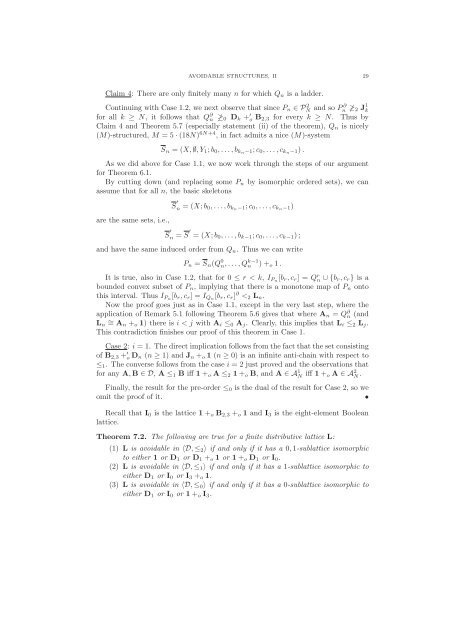Avoidable structures, II: finite distributive lattices and nicely ...
Avoidable structures, II: finite distributive lattices and nicely ...
Avoidable structures, II: finite distributive lattices and nicely ...
You also want an ePaper? Increase the reach of your titles
YUMPU automatically turns print PDFs into web optimized ePapers that Google loves.
AVOIDABLE STRUCTURES, <strong>II</strong> 29<br />
Claim 4: There are only <strong>finite</strong>ly many n for which Q n is a ladder.<br />
Continuing with Case 1.2, we next observe that since P n ∈ P 2 N <strong>and</strong> so P∂ n ≱ 2 J 1 k<br />
for all k ≥ N, it follows that Q ∂ n ≱ 0 D k + ′ o B 2,3 for every k ≥ N. Thus by<br />
Claim 4 <strong>and</strong> Theorem 5.7 (especially statement (ii) of the theorem), Q n is <strong>nicely</strong><br />
(M)-structured, M = 5·(18N) 6N+4 , in fact admits a nice (M)-system<br />
S n = (X,∅,Y 1 ;b 0 ,...,b kn−1;c 0 ,...,c kn−1).<br />
As we did above for Case 1.1, we now work through the steps of our argument<br />
for Theorem 6.1.<br />
By cutting down (<strong>and</strong> replacing some P n by isomorphic ordered sets), we can<br />
assume that for all n, the basic skeletons<br />
are the same sets, i.e.,<br />
S ′ n = (X;b 0 ,...,b kn−1;c 0 ,...,c kn−1)<br />
S ′ n = S ′ = (X;b 0 ,...,b k−1 ;c 0 ,...,c k−1 );<br />
<strong>and</strong> have the same induced order from Q n . Thus we can write<br />
P n = S n (Q 0 n,...,Q k−1<br />
n )+ o 1.<br />
It is true, also in Case 1.2, that for 0 ≤ r < k, I Pn [b r ,c r ] = Q r n ∪ {b r ,c r } is a<br />
bounded convex subset of P n , implying that there is a monotone map of P n onto<br />
this interval. Thus I Pn [b r ,c r ] = I Qn [b r ,c r ] ∂ < 2 L n .<br />
Now the proof goes just as in Case 1.1, except in the very last step, where the<br />
application of Remark 5.1 following Theorem 5.6 gives that where A n = Q ∂ n (<strong>and</strong><br />
L n<br />
∼ = An + o 1) there is i < j with A i ≤ 0 A j . Clearly, this implies that L i ≤ 2 L j .<br />
This contradiction finishes our proof of this theorem in Case 1.<br />
Case 2: i = 1. The directimplication follows from thefact that the setconsisting<br />
of B 2,3 + ′ oD n (n ≥ 1) <strong>and</strong> J n + o 1 (n ≥ 0) is an in<strong>finite</strong> anti-chain with respect to<br />
≤ 1 . The converse follows from the case i = 2 just proved <strong>and</strong> the observations that<br />
for any A,B ∈ D, A ≤ 1 B iff 1+ o A ≤ 2 1+ o B, <strong>and</strong> A ∈ A 1 N iff 1+ o A ∈ A 2 N .<br />
Finally, the result for the pre-order ≤ 0 is the dual of the result for Case 2, so we<br />
omit the proof of it.<br />
•<br />
Recall that I 0 is the lattice 1+ o B 2,3 + o 1 <strong>and</strong> I 3 is the eight-element Boolean<br />
lattice.<br />
Theorem 7.2. The following are true for a <strong>finite</strong> <strong>distributive</strong> lattice L:<br />
(1) L is avoidable in 〈D,≤ 2 〉 if <strong>and</strong> only if it has a 0,1-sublattice isomorphic<br />
to either 1 or D 1 or D 1 + o 1 or 1+ o D 1 or I 0 .<br />
(2) L is avoidable in 〈D,≤ 1 〉 if <strong>and</strong> only if it has a 1-sublattice isomorphic to<br />
either D 1 or I 0 or I 3 + o 1.<br />
(3) L is avoidable in 〈D,≤ 0 〉 if <strong>and</strong> only if it has a 0-sublattice isomorphic to<br />
either D 1 or I 0 or 1+ o I 3 .
















